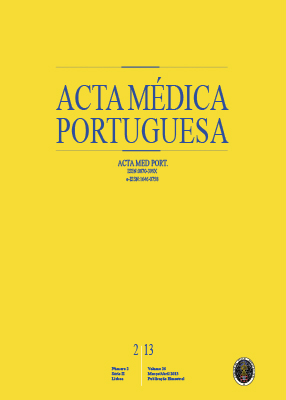A Community-Based Study of Stroke Code Users in Northern Portugal
DOI:
https://doi.org/10.20344/amp.4103Abstract
Introduction: By 2002 Portugal had one of the highest mortality rates due to cerebrovascular diseases among the European Countries. Meanwhile, several strategies have been adopted to improve prevention and treatment in the acute phase, amongst which the Stroke Code. The purpose of this study is to describe how this measure has been used and its outcome as part of a prospective community based study of stroke/TIA incidence in Northern Portugal. Materials and Methods: Between 1st October 2009 and 30th September 2010 all strokes occurred in patients registered at Western Porto, Mirandela and Vila Pouca de Aguiar health centres have been recorded. For cases ascertainment multiple sources of information were used, including the WEB, letter, e-mail and Alert P1, as well as systematic searches on databases provided by the entities involved in this study: hospital emergency, discharge records, diagnosis procedures, death certificates, Stroke Code admissions and health centre emergency records. Results: Six hundred strokes were recorded in a population of 241 000 (incidence rate of 250 / 100 000 person-years) and 434 were first-ever-in-the-lifetime (180 / 100 000). There were 72 Stroke Code calls and in 66.7% of them a stroke was confirmed. Considering the criteria for Stroke Code call (age ≤ 80 years, functional independency, the stroke signs/symptoms, and time after episode ≤ 3 hours), only 15.9% patients “could” have access to it. Of those who used the Stroke Code, only 56.3% fulfilled the criteria. Considering all patients fulfilling Stroke Code criteria, 96.3% that used prehospital Stroke Code were inpatients, as well as 83.3% that used intra/interhospital Stroke Code and 64.0% of the remainder; this trend is also present in patients with ischaemic stroke submitted to fibrinolysis, 77.3%, 36.4% and 17.4%, respectively. A high post-stroke Rankin was more frequent among Stroke Code users (70.3% vs. 35.3%), but they exhibit more often the three stroke signs/symptoms (44.0% vs. 16.2%). After adjusting for age, sex and number of signs, the risk of a more severe post-stroke Rankin is not significantly different among patients using the prehospital Stroke Code (OR = 2.9, 95% CI: 0.8 - 10.2). Conclusions: The criteria for accessing the Stroke Code are currently restrictive. Though the Stroke Code is accessed in case of more severe patient’s conditions, the proportion of patients treated with fibrinolysis is relatively high in comparison with other studies.
Downloads
Downloads
How to Cite
Issue
Section
License
All the articles published in the AMP are open access and comply with the requirements of funding agencies or academic institutions. The AMP is governed by the terms of the Creative Commons ‘Attribution – Non-Commercial Use - (CC-BY-NC)’ license, regarding the use by third parties.
It is the author’s responsibility to obtain approval for the reproduction of figures, tables, etc. from other publications.
Upon acceptance of an article for publication, the authors will be asked to complete the ICMJE “Copyright Liability and Copyright Sharing Statement “(http://www.actamedicaportuguesa.com/info/AMP-NormasPublicacao.pdf) and the “Declaration of Potential Conflicts of Interest” (http:// www.icmje.org/conflicts-of-interest). An e-mail will be sent to the corresponding author to acknowledge receipt of the manuscript.
After publication, the authors are authorised to make their articles available in repositories of their institutions of origin, as long as they always mention where they were published and according to the Creative Commons license.









